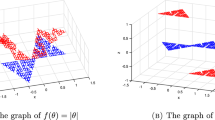Abstract
We present two mathematical models that describe human red blood cells (RBCs) with morphologies that are attained naturally under certain patho-physiological conditions, namely stomatocytes and echinocytes. Muñoz San Martín et al. (Bioelectromagnetics 27:521–527, 2006) recently presented models of these shapes based on our previous set of parametric equations (Kuchel and Fackerell, Bull. Math. Biol. 61:209–220, 1999) that involve Jacobi elliptic functions and integrals. Thus, both discocytes and stomatocytes are described. Here, we derived the Cartesian forms of these new equations; and, in addition, present a realistic model of a Type III echinocyte, using prolate spheroids ‘decorating’ a central sphere at the vertices of an internal dodecahedron. The RBC models based on Cartesian equations have been used for representing the shape changes (morphological transformations or “morphing”) that occur in RBCs under various experimental conditions; specifically, when the shape changes have been monitored by nuclear magnetic resonance (NMR) micro-imaging.
Similar content being viewed by others
Abbreviations
- NMR:
-
nuclear magnetic resonance
- RBC:
-
red blood cell
References
Abramowitz, M., Stegun, I.A., 1968. Handbook of Mathematical Functions with Formulas, Graphs, and Mathematical Tables. US Govt. Print. Off., Washington.
Beck, J.S., 1978. Relations between membrane monolayers in some red-cell shape transformations. J. Theor. Biol. 75, 487–501.
Bessis, M., 1972. Red-cell shapes—illustrated classification and its rationale. Nouv. Rev. Fr. Hematol. 12, 721–746.
Byrd, P.F., Friedman, M.D., 1971. Handbook of Elliptic Integrals for Engineers and Scientists, 2nd edn. Springer, New York.
di Biasio, A., Ambrosone, L., Cametti, C., 2009. Numerical simulation of dielectric spectra of aqueous suspensions of non-spheroidal differently shaped biological cells. J. Phys. D 42, 025401.
Iglič, A., 1997. A possible mechanism determining the stability of spiculated red blood cells. J. Biomech. 30, 35–40.
Kuchel, P.W., Bulliman, B.T., 1988. Expressions for surfaces in disk-cyclide coordinates—derivations using symbolic computation. J. Franklin Inst. 325, 505–508.
Kuchel, P.W., Fackerell, E.D., 1999. Parametric-equation representation of biconcave erythrocytes. Bull. Math. Biol. 61, 209–220.
Kuchel, P.W., Bulliman, B.T., Fackerell, E.D., 1987. Bi-cyclide and flat-ring cyclide coordinate surfaces—correction of two expressions. Math. Comput. 49, 607–613.
Kuzman, D., Svetina, S., Waugh, R.E., Žekš, B., 2004. Elastic properties of the red blood cell membrane that determine echinocyte deformability. Eur. Biophys. J. 33, 1–15.
Larkin, T.J., Kuchel, P.W., 2009. Erythrocyte orientational and cell volume effects on NMR q-space analysis: simulations of restricted diffusion. Eur. Biophys. J. 39, 139–148.
Lim, H.W.G., Wortis, M., Mukhopadhyay, R., 2002. Stomatocyte-discocyte-echinocyte sequence of the human red blood cell: evidence for the bilayer-couple hypothesis from membrane mechanics. Proc. Natl. Acad. Sci. USA 99, 16766–16769.
Martino, R., Negri, M., Di Marco, A., 1980. Simple, geometrical model for a typical echinocyte-III. Experientia 36, 302–303.
Moon, P., Spencer, D.E., 1953. Some coordinate systems associated with elliptic functions. J. Franklin Inst. 255, 531–543.
Moon, P., Spencer, D.E., 1961. Field Theory for Engineers. Van-Nostrand, Princeton.
Moon, P., Spencer, D.E., 1988. Field Theory Handbook. Including Coordinate Systems, Differential Equations and Their Solutions. Springer, Berlin.
Mukhopadhyay, R., Lim, G., Wortis, M., 2002. Echinocyte shapes: bending, stretching, and shear determine spicule shape and spacing. Biophys. J. 82, 1756–1772.
Muñoz, S., Sebastián, J.L., Sancho, M., Miranda, J.M., 2004. Transmembrane voltage induced on altered erythrocyte shapes exposed to RF fields. Bioelectromagnetics 25, 631–633.
Muñoz San Martín, S., Sebastián, J.L., Sancho, M., Miranda, J.M., 2003. A study of the electric field distribution in erythrocyte and rod shape cells from direct RF exposure. Phys. Med. Biol. 48, 1649–1659.
Muñoz San Martín, S., Sebastián, J.L., Sancho, M., Álvarez, G., 2006. Modeling normal and altered human erythrocyte shapes by a new parametric equation: application to the calculation of induced transmembrane potentials. Bioelectromagnetics 27, 521–527.
Pages, G., Szekely, D., Kuchel, P.W., 2008. Erythrocyte-shape evolution recorded with fast-measurement NMR diffusion-diffraction. J. Magn. Reson. Imaging 28, 1409–1416.
Regan, D.G., Kuchel, P.W., 2003. Simulations of NMR-detected diffusion in suspensions of red cells: the “signatures” in q-space plots of various lattice arrangements. Eur. Biophys. J. 31, 563–574.
Sebastián, J.L., San Martín, S.M., Sancho, M., Miranda, J.M., Álvarez, G., 2005. Erythrocyte rouleau formation under polarized electromagnetic fields. Phys. Rev. E 72, 031913.
Szekely, D., Chapman, B.E., Bubb, W.A., Kuchel, P.W., 2006. Rapid exchange of fluoroethylamine via the rhesus complex in human erythrocytes: 19F NMR magnetization transfer analysis showing competition by ammonia and ammonia analogues. Biochemistry 45, 9354–9361.
Vayo, H.W., 1983. Some red-cell geometry. Can. J. Physiol. Pharmacol. 61, 646–649.
Waugh, R.E., 1996. Elastic energy of curvature-driven bump formation on red blood cell membrane. Biophys. J. 70, 1027–1035.
Wolfram, S. 2008. The Mathematica Book, 7th edn. Wolfram Media/Cambridge University Press, Champaign.
Author information
Authors and Affiliations
Corresponding author
Rights and permissions
About this article
Cite this article
Larkin, T.J., Kuchel, P.W. Mathematical Models of Naturally “Morphed” Human Erythrocytes: Stomatocytes and Echinocytes. Bull. Math. Biol. 72, 1323–1333 (2010). https://doi.org/10.1007/s11538-009-9493-8
Received:
Accepted:
Published:
Issue Date:
DOI: https://doi.org/10.1007/s11538-009-9493-8




